Transport costs
Contents
Transport costs¶
📖 Ahead of time…¶
💻 Hands-on coding¶
import momepy
import geopandas
import contextily
import xarray, rioxarray
import osmnx as ox
import numpy as np
import matplotlib.pyplot as plt
ox.settings.overpass_settings = (
'[out:json][timeout:90][date:"2021-03-07T00:00:00Z"]'
)
Assuming you have the file locally on the path ../data/:
streets = geopandas.read_file("../data/arturo_streets.gpkg")
abbs = geopandas.read_file("../data/madrid_abb.gpkg")
neis = geopandas.read_file("../data/neighbourhoods.geojson")
If you’re online, you can do:
streets = geopandas.read_file(
"https://darribas.org/gds4ae/_downloads/67d5480f98453027d59bf49606a7ad92/arturo_streets.gpkg"
)
abbs = geopandas.read_file(
"https://github.com/GDSL-UL/san/raw/v0.1.0/data/assignment_1_madrid/madrid_abb.gpkg"
)
neis = geopandas.read_file(
"http://darribas.org/gds4ae/_downloads/44b4bc22c042386c2c0f8dc6685ef17c/neighbourhoods.geojson"
)
pandana graphs¶
import pandana
Before building the routing network, we convert to graph and back in momepy to “clean” the network and ensure it complies with requirements for routing.
%%time
nodes, edges = momepy.nx_to_gdf( # Convert back to geo-table
momepy.gdf_to_nx( # Convert to a clean NX graph
streets.explode(index_parts='True') # We "explode" to avoid multi-part rows
)
)
nodes = nodes.set_index("nodeID")# Reindex nodes on ID
CPU times: user 3.2 s, sys: 76.5 ms, total: 3.27 s
Wall time: 3.24 s
Once we have nodes and edges “clean” from the graph representation, we can build a pandana.Network object we will use for routing:
streets_pdn = pandana.Network(
nodes.geometry.x,
nodes.geometry.y,
edges["node_start"],
edges["node_end"],
edges[["mm_len"]]
)
streets_pdn
Generating contraction hierarchies with 16 threads.
Setting CH node vector of size 49985
Setting CH edge vector of size 66499
Range graph removed 444 edges of 132998
. 10% . 20% . 30% . 40% . 50% . 60% . 70% . 80% . 90% . 100%
<pandana.network.Network at 0x7fbbc3db5d00>
Shortest-path routing¶
How do I go from A to B?
For example, from the first Airbnb in the geo-table…
first = abbs.loc[[0], :].to_crs(streets.crs)
…to Puerta del Sol.
import geopy
geopy.geocoders.options.default_user_agent = "gds4ae"
sol = geopandas.tools.geocode(
"Puerta del Sol, Madrid", geopy.Nominatim
).to_crs(streets.crs)
sol
| geometry | address | |
|---|---|---|
| 0 | POINT (440247.314 4474264.131) | Puerta del Sol, Barrio de los Austrias, Sol, C... |
First we snap locations to the network:
pt_nodes = streets_pdn.get_node_ids(
[first.geometry.x.iloc[0], sol.geometry.x.iloc[0]],
[first.geometry.y.iloc[0], sol.geometry.y.iloc[0]]
)
pt_nodes
0 3071
1 35731
Name: node_id, dtype: int64
Then we can route the shortest path:
route_nodes = streets_pdn.shortest_path(
pt_nodes[0], pt_nodes[1]
)
route_nodes
array([ 3071, 3476, 8268, 8266, 8267, 18695, 18693, 1432, 1430,
353, 8175, 8176, 18121, 17476, 16858, 14322, 16857, 17810,
44795, 41220, 41217, 41221, 41652, 18924, 18928, 48943, 18931,
21094, 21095, 23219, 15398, 15399, 15400, 47446, 47447, 23276,
47448, 23259, 23260, 23261, 27951, 27952, 27953, 48327, 11950,
11949, 11944, 19475, 19476, 27333, 30088, 43294, 11940, 11941,
11942, 48325, 37484, 48316, 15893, 15890, 15891, 29954, 25453,
7341, 34991, 23608, 28217, 21648, 21649, 21651, 39075, 25108,
25102, 25101, 25100, 48518, 47287, 34623, 31187, 29615, 48556,
22844, 48553, 48555, 40922, 40921, 40923, 48585, 46372, 46371,
46370, 45675, 45676, 38778, 38777, 19144, 20498, 20497, 20499,
47737, 42303, 42302, 35730, 35727, 35729, 35731])
With this information, we can build the route line manually:
from shapely.geometry import LineString
def route_nodes_to_line(nodes, network):
pts = network.nodes_df.loc[nodes, :]
s = geopandas.GeoDataFrame(
{"src_node": [nodes[0]], "tgt_node": [nodes[1]]},
geometry=[LineString(pts.values)],
crs=streets.crs
)
return s
We can calculate the route:
route = route_nodes_to_line(route_nodes, streets_pdn)
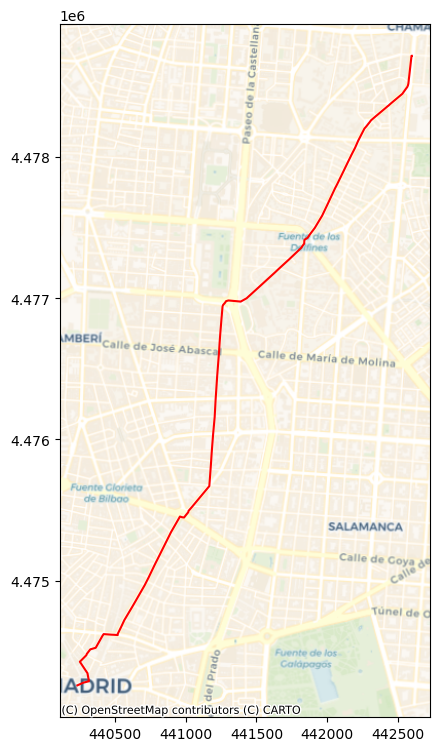
And we get it back as a geo-table (with one row):
route
| src_node | tgt_node | geometry | |
|---|---|---|---|
| 0 | 3071 | 3476 | LINESTRING (442606.507 4478714.516, 442597.100... |
If we wanted to obtain the length of the route:
route_len = streets_pdn.shortest_path_length(
pt_nodes[0], pt_nodes[1]
)
round(route_len / 1000, 3) # Dist in Km
5.514
Challenge
What is the network distance between CEMFI and Puerta del Sol?
BONUS I: how much longer is it than if you could fly in a straight line?
BONUS II: if one walks at a speed of 5 Km/h, how long does the walk take you?
Weighted routing¶
How do I go from A to B passing by the “best” buildings?
This is really an extension of standard routing that takes advantage of the flexibility of pandana.Network objects.
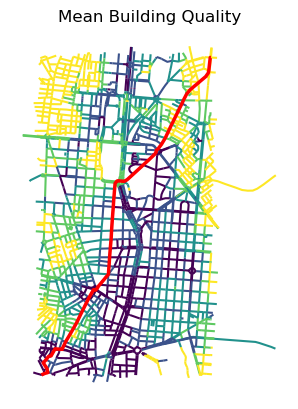
The overall process is the same; the main difference is, when we build the Network object, to replace distance (mm_len) with a measure that combines distance and building quality. Note that we want to maximise building quality, but the routing algorithms use a minimisation function. Hence, our composite index will need to reflect that.
The strategy is divided in the following steps:
Re-scale distance between 0 and 1
Build a measure inverse to building quality in the \([0, 1]\) range
Generate a combined measure (
wdist) by picking a weighting parameterBuild a new
Networkobject that incorporateswdistinstead of distanceCompute route between the two points of interest
For 1., we can use the scaler in scikit-learn:
from sklearn.preprocessing import minmax_scale
Then generate and attach to edges a scaled version of mm_len:
edges["scaled_dist"] = minmax_scale(edges["mm_len"])
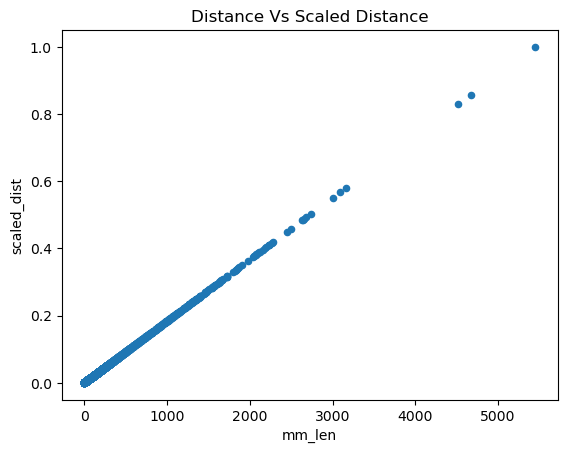
We move on to 2., with a similar approach. We will use the negative of the building quality average (average_quality):
edges["scaled_inv_bquality"] = minmax_scale(
-edges["average_quality"]
)
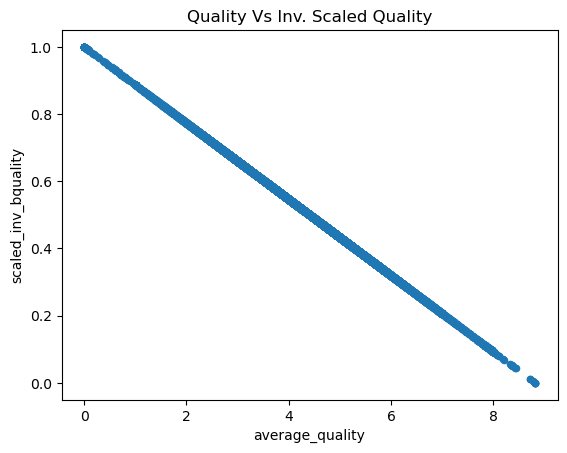
Taking 1. and 2. into 3. we can build wdist. For this example, we will give each dimension the same weight (0.5), but this is at discretion of the researcher.
w = 0.5
edges["wdist"] = (
edges["scaled_dist"] * w +
edges["scaled_inv_bquality"] * (1-w)
)
Now we can recreate the Network object based on our new measure (4.) and provide routing. Since it is the same process as with distance, we will do it all in one go:
# Build new graph object
w_graph = pandana.Network(
nodes.geometry.x,
nodes.geometry.y,
edges["node_start"],
edges["node_end"],
edges[["wdist"]]
)
# Snap locations to their nearest node
pt_nodes = w_graph.get_node_ids(
[first.geometry.x.iloc[0], sol.geometry.x.iloc[0]],
[first.geometry.y.iloc[0], sol.geometry.y.iloc[0]]
)
# Generate route
w_route_nodes = w_graph.shortest_path(
pt_nodes[0], pt_nodes[1]
)
# Build LineString
w_route = route_nodes_to_line(
w_route_nodes, w_graph
)
Generating contraction hierarchies with 16 threads.
Setting CH node vector of size 49985
Setting CH edge vector of size 66499
Range graph removed 444 edges of 132998
. 10% . 20% . 30% . 40% . 50% . 60% . 70% . 80% . 90% . 100%
Now we are ready to display it on a map:
# Building quality
ax = streets.plot(
"average_quality",
scheme="quantiles",
cmap="magma",
linewidth=0.5,
figsize=(9, 9)
)
# Shortest route
route.plot(
color="xkcd:orange red", linewidth=3, ax=ax, label="Shortest"
)
# Weighted route
w_route.plot(
color="xkcd:easter green", linewidth=3, ax=ax, label="Weighted"
)
# Styling
ax.set_axis_off()
plt.legend();
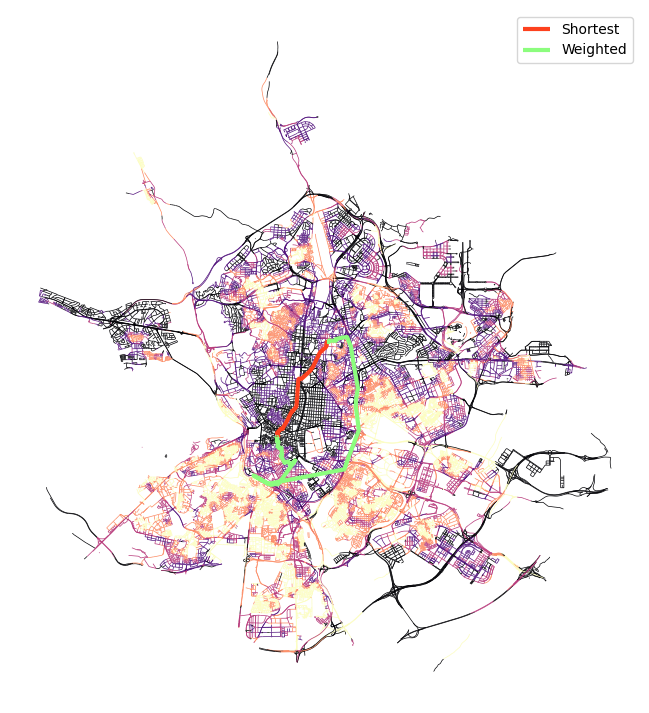
Challenge
Explore the differences in the output of weighted routing if you change the weight between distance and the additional constrain.
Recreate weighted routing using the linearity of street segments. How can you go from A to B avoiding long streets?
Proximity¶
What is the nearest internet cafe for Airbnb’s without WiFi?
First we identify Airbnb’s without WiFi:
no_wifi = abbs.query(
"WiFi == '0'"
).to_crs(streets.crs)
Then pull WiFi spots in Madrid from OpenStreetMap:
icafes = ox.features_from_place(
"Madrid, Spain", tags={"amenity": "internet_cafe"}
).to_crs(streets.crs).reset_index()
ax = no_wifi.plot(
color="red",
markersize=1,
alpha=0.5,
label="Airbnb no WiFi",
figsize=(9, 9)
)
icafes.plot(
ax=ax, color="lime", label="Internet cafes"
)
contextily.add_basemap(
ax,
crs=no_wifi.crs,
source=contextily.providers.CartoDB.Voyager
)
ax.set_axis_off()
plt.legend()
plt.show()
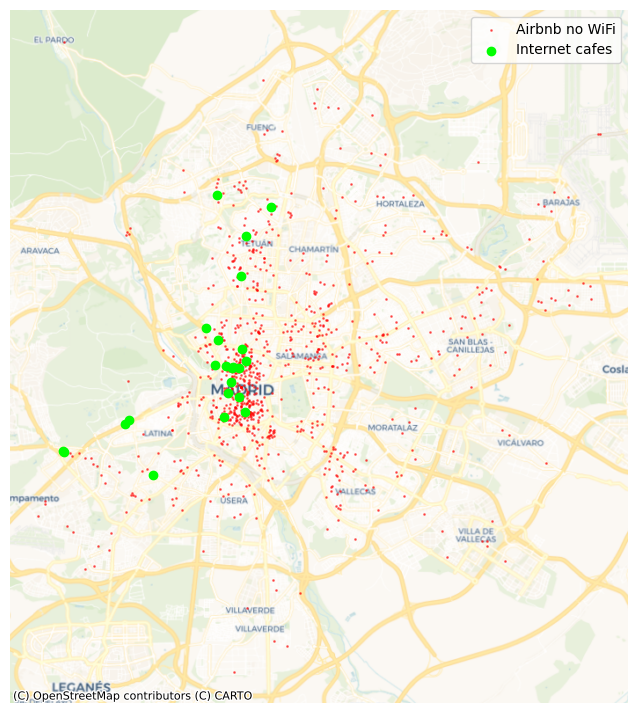
The logic for this operation is the following:
Add the points of interest (POIs, the internet cafes) to the network object (
streets_pdn)Find the nearest node to each POI
Find the nearest node to each Airbnb without WiFi
Connect each Airbnb to its nearest internet cafe
We can add the internet cafes to the network object (1.) with the set_pois method:
streets_pdn.set_pois(
category="Internet cafes", # Our name for the layer in the `Network` object
maxitems=1, # Use to count only nearest cafe
maxdist=100000, # 100km so everything is included
x_col=icafes.geometry.x, # X coords of cafes
y_col=icafes.geometry.y, # Y coords of cafes
)
Once the cafes are added to the network, we can find the nearest one to each node (2.):
cafe2nnode = streets_pdn.nearest_pois(
100000, # Max distance to look for
"Internet cafes", # POIs to look for
num_pois=1, # No. of POIs to include
include_poi_ids=True # Store POI ID
).join(# Then add the internet cafee IDs and name
icafes[['osmid', 'name']],
on="poi1"
).rename(# Rename the distance from node to cafe
columns={1: "dist2icafe"}
)
cafe2nnode.head()
| dist2icafe | poi1 | osmid | name | |
|---|---|---|---|---|
| nodeID | ||||
| 0 | 5101.421875 | 9.0 | 3.770327e+09 | Silver Envíos 2 |
| 1 | 5190.265137 | 9.0 | 3.770327e+09 | Silver Envíos 2 |
| 2 | 5252.475098 | 9.0 | 3.770327e+09 | Silver Envíos 2 |
| 3 | 5095.101074 | 9.0 | 3.770327e+09 | Silver Envíos 2 |
| 4 | 5676.117188 | 9.0 | 3.770327e+09 | Silver Envíos 2 |
Note that, to make things easier down the line, we can link cafe2nnode to the cafe IDs.
And we can also link Airbnb’s to nodes (3.) following a similar approach as we have seen above:
abbs_nnode = streets_pdn.get_node_ids(
no_wifi.geometry.x, no_wifi.geometry.y
)
abbs_nnode.head()
26 8872
50 10905
62 41158
63 34257
221 32215
Name: node_id, dtype: int64
Finally, we can bring together both to find out what is the nearest internet cafe for each Airbnb (4.):
abb_icafe = no_wifi[
["geometry"] # Keep only geometries of ABBs w/o WiFi
].assign(
nnode=abbs_nnode # Attach to thse ABBs the nearest node in the network
).join( # Join to each ABB the nearest cafe using node IDs
cafe2nnode,
on="nnode"
)
abb_icafe.head()
| geometry | nnode | dist2icafe | poi1 | osmid | name | |
|---|---|---|---|---|---|---|
| 26 | POINT (443128.256 4483599.841) | 8872 | 4926.223145 | 9.0 | 3.770327e+09 | Silver Envíos 2 |
| 50 | POINT (441885.677 4475916.602) | 10905 | 1876.392944 | 19.0 | 6.922981e+09 | Locutorio |
| 62 | POINT (440439.640 4476480.771) | 41158 | 1164.812988 | 17.0 | 5.573414e+09 | NaN |
| 63 | POINT (438485.311 4471714.377) | 34257 | 1466.537964 | 5.0 | 2.304485e+09 | NaN |
| 221 | POINT (439941.104 4473117.914) | 32215 | 354.268005 | 15.0 | 5.412145e+09 | NaN |
Challenge
Calculate distances to nearest internet cafe for ABBs with WiFi. On average, which of the two groups (with and without WiFi) are closer to internet cafes?
Accessibility¶
This flips the previous question on its head and, instead of asking what is the nearest POI to a given point, along the network (irrespective of distance), it asks how many POIs can I access within a network-based distance radious?
%%time
parks = ox.features_from_place(
"Madrid, Spain", tags={"leisure": "park"}
).to_crs(streets.crs)
CPU times: user 382 ms, sys: 461 µs, total: 382 ms
Wall time: 385 ms
How many parks are within 500m(-euclidean) of an Airbnb?
We draw a radious of 500m around each AirBnb:
buffers = geopandas.GeoDataFrame(
geometry=abbs.to_crs(
streets.crs
).buffer(
500
)
)
Then intersect it with the location of parks, and count by buffer (ie. Airbnb):
park_count = geopandas.sjoin(
parks, buffers
).groupby(
"index_right"
).size()
How many parks are within 500m(-network) of an Airbnb?
We need to approach this as a calculation within the network. The logic of steps thus looks like:
Use the aggregation module in
pandanato count the number of parks within 500m of each node in the networkExtract the counts for the nodes nearest to Airbnb properties
Assign park counts to each Airbnb
We can set up the aggregate engine (1.). This involves three steps:
a. Obtain nearest node for each park
parks_nnode = streets_pdn.get_node_ids(
parks.centroid.x, parks.centroid.y
)
b. Insert the parks’ nearest node through set so it can be “aggregated”
streets_pdn.set(
parks_nnode, name="Parks"
)
c. “Aggregate” for a distance of 500m, effectively counting the number of parks within 500m of each node
parks_by_node = streets_pdn.aggregate(
distance=500, type="count", name="Parks"
)
parks_by_node.head()
nodeID
0 5.0
1 5.0
2 6.0
3 8.0
4 1.0
dtype: float64
At this point, we have the number of parks within 500m of every node in the network. To identify those that correspond to each Airbnb (3.), we first pull out the nearest nodes to each ABB:
abbs_xys = abbs.to_crs(streets.crs).geometry
abbs_nnode = streets_pdn.get_node_ids(
abbs_xys.x, abbs_xys.y
)
And use the list to asign the count of the nearest node to each Airbnb:
park_count_network = abbs_nnode.map(
parks_by_node
)
park_count_network.head()
0 4.0
1 9.0
2 5.0
3 0.0
4 12.0
Name: node_id, dtype: float64
For which areas do both differ most?
We can compare the two counts above to explore to what extent the street layout is constraining access to nearby parks.
park_comp = geopandas.GeoDataFrame(
{
"Euclidean": park_count,
"Network": park_count_network
},
geometry=abbs.geometry,
crs=abbs.crs
)
ax = park_comp.plot.scatter("Euclidean", "Network")
ax.axline([0, 0], [1, 1], color='red');# 45deg line
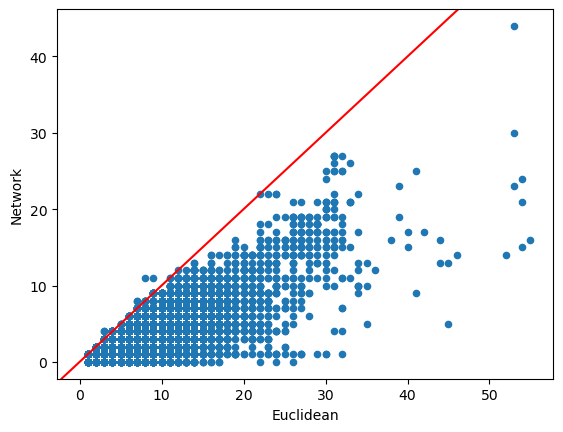
And, geographically:
f, axs = plt.subplots(1, 3, figsize=(15, 5))
# Euclidean count
abbs.to_crs(
streets.crs
).assign(
n_parks=park_count
).fillna(0).plot(
"n_parks",
scheme="fisherjenkssampled",
alpha=0.5,
markersize=1,
figsize=(9, 9),
legend=True,
ax=axs[0]
)
contextily.add_basemap(
axs[0],
crs=streets.crs,
source=contextily.providers.CartoDB.PositronNoLabels
)
axs[0].set_axis_off()
axs[0].set_title("Euclidean Distances")
# Count difference
with_parks = park_comp.query(
"(Network > 0) & (Euclidean > 0)"
)
count_diff = 100 * (
with_parks["Euclidean"] -
with_parks["Network"]
) / with_parks["Euclidean"]
abbs.to_crs(
streets.crs
).assign(
n_parks=count_diff
).dropna().plot(
"n_parks",
scheme="fisherjenkssampled",
alpha=0.5,
markersize=1,
figsize=(9, 9),
legend=True,
ax=axs[1]
)
contextily.add_basemap(
axs[1],
crs=streets.crs,
source=contextily.providers.CartoDB.PositronNoLabels
)
axs[1].set_axis_off()
axs[1].set_title("Count Difference (%)")
# Network count
abbs.to_crs(
streets.crs
).assign(
n_parks=park_count_network
).fillna(0).plot(
"n_parks",
scheme="fisherjenkssampled",
alpha=0.5,
markersize=1,
figsize=(9, 9),
legend=True,
ax=axs[2]
)
contextily.add_basemap(
axs[2],
crs=streets.crs,
source=contextily.providers.CartoDB.PositronNoLabels
)
axs[2].set_axis_off()
axs[2].set_title("Network Distances")
plt.show()

Challenge
Calculate accessibility to other ABBs from each ABB through the network. How many ABBs can you access within 500m of each ABB?
Note you will need to use the locations of ABBs both as the source and the target for routing in this case.
🐾 Next steps¶
If you found the content in this block useful, the following resources represent some suggestions on where to go next:
The
pandanatutorial and documentation are excellent places to get a more detailed and comprehensive view into the functionality of the library